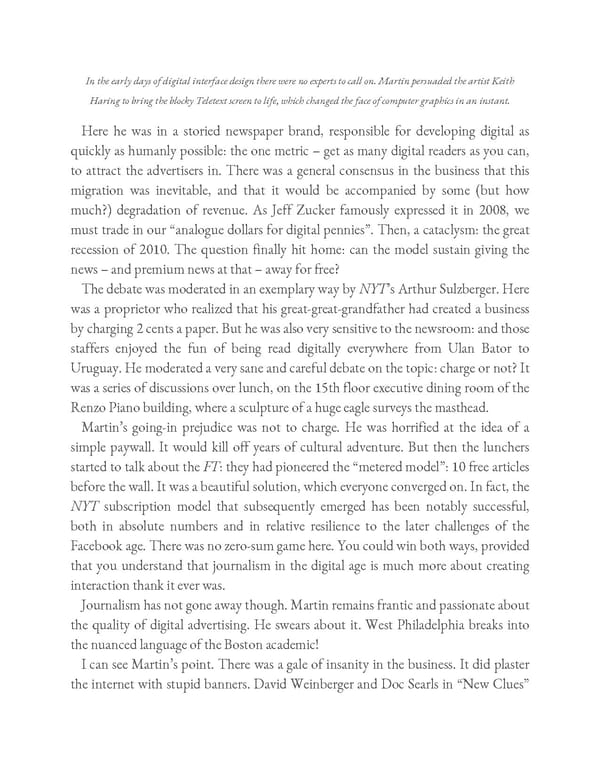In the early days of digital interface design there were no experts to call on. Martin persuaded the artist Keith Haring to bring the blocky Teletext screen to life, which changed the face of computer graphics in an instant. Here he was in a storied newspaper brand, responsible for developing digital as quickly as humanly possible: the one metric – get as many digital readers as you can, to attract the advertisers in. There was a general consensus in the business that this migration was inevitable, and that it would be accompanied by some (but how much?) degradation of revenue. As Jeff Zucker famously expressed it in 2008, we must trade in our “analogue dollars for digital pennies”. Then, a cataclysm: the great recession of 2010. The question finally hit home: can the model sustain giving the news – and premium news at that – away for free? The debate was moderated in an exemplary way by NYT’s Arthur Sulzberger. Here was a proprietor who realized that his great-great-grandfather had created a business by charging 2 cents a paper. But he was also very sensitive to the newsroom: and those staffers enjoyed the fun of being read digitally everywhere from Ulan Bator to Uruguay. He moderated a very sane and careful debate on the topic: charge or not? It was a series of discussions over lunch, on the 15th floor executive dining room of the Renzo Piano building, where a sculpture of a huge eagle surveys the masthead. Martin’s going-in prejudice was not to charge. He was horrified at the idea of a simple paywall. It would kill off years of cultural adventure. But then the lunchers started to talk about the FT: they had pioneered the “metered model”: 10 free articles before the wall. It was a beautiful solution, which everyone converged on. In fact, the NYT subscription model that subsequently emerged has been notably successful, both in absolute numbers and in relative resilience to the later challenges of the Facebook age. There was no zero-sum game here. You could win both ways, provided that you understand that journalism in the digital age is much more about creating interaction thank it ever was. Journalism has not gone away though. Martin remains frantic and passionate about the quality of digital advertising. He swears about it. West Philadelphia breaks into the nuanced language of the Boston academic! I can see Martin’s point. There was a gale of insanity in the business. It did plaster the internet with stupid banners. David Weinberger and Doc Searls in “New Clues”
 Ogilvy on Advertising in the Digital Age Page 376 Page 378
Ogilvy on Advertising in the Digital Age Page 376 Page 378